Equipment of the Carthaginian Army
This article is incomplete because it is pending further input from participants, or it is a work-in-progress by one author. Please comment on this article's talk page to share your input, comments and questions. Note: To contribute to this article, you may need to seek help from the author(s) of this page. |
The following is a list of equipment of the Army of Carthage. It includes small arms, combat vehicles, aircraft, watercraft, artillery, and support vehicles. To fulfill its role in defense of the republic and its interests, the Army of Carthage fields a wide variety of modern equipment, continuously modifying and updating this roster to remain an effective combat force. For political and security reasons, most equipment is procured either domestically or from trusted allies, especially in highly technical fields.
Under the provisions of the 1994 Unified Military Procurement Act, much of this equipment is shared with other branches of the military, especially in the area of small arms, utility vehicles, and protected carriers. To combat unforeseen shortages or unexpected requirements, the standard procurement system can be bypassed using an Urgent Operational Requirement (UOR), which allows for the rapid fielding of equipment outside of scheduled purchases.
Infantry squad equipment
A Carthaginian mechanized infantry squad is normally composed of two four-man fire teams plus the squad leader, for a total of nine men. In normal operations, each squad is equipped with the following:
Weapons
|
Communication equipment
Vision equipment
|
The squad leader is normally armed as a rifleman and accompanies one of the two fire teams, or coordinates the mission from the squad's personnel carrier or fighting vehicle. In addition, squad leaders also carry a BCL-S radio and smoke grenades for marking relevant locations. Both fire team leaders are also armed as riflemen and the squad is divided into assault and support teams. The assault team is composed of a team leader, grenadier, and two riflemen while the support team is composed of a team leader, automatic rifleman, and two-man recoilless launcher team.
Infantry squads may carry additional mission-specific equipment, and the Army is in the process of increasing the number of G/KME-443 helmet systems to one per soldier up from two per fire team under the Infantry Modernization Program. Despite an emphasis on providing motorized or mechanized support for infantry wherever possible and ongoing weight-reduction programs for existing infantry equipment, critics have contended that the increasing trend toward additional sensor and communications equipment has left troops overburdened and more vulnerable to electronic warfare. Supporters have countered that the introduction of lightened gear and consolidated electronics has not significantly altered the warfighter's burden, while the significant improvements in lethality and capability offered by these systems makes them a necessity in order to remain competitive with foreign armies.
Personal equipment
Protective equipment
The KPH-460 Protective Headgear System is the current standard-issue helmet of the Carthaginian Army. Unlike previous helmets made from layered aramid fibers, the KPH-460 is made from ultra-high-molecular-weight polyethylene, which provides superior protection compared to older designs. The helmet includes a cushion for the head as well as an H-back multi-point strap system, and an optional nape pad to improve blast protection for the back of the head. The helmet is normally painted an olive drab color but may be used with cloth helmet covers in other environments. Attachment rails for night vision systems, lights, and communication equipment are also included, along with hook-and-loop sections for other accessories.
Since 2011 the current body armor system of the Carthaginian Army has been the KPB-462 Modular Protective System, which replaced the older Infantry Body Armor system. The MPS is centered around a conventional tactical vest, with attachment points for plate bags carrying rifle plates. Additional shoulder, groin, and neck protector sections may also be attached to the vest, allowing it to be tailored for specific missions and roles. Without the ballistic plates, the vest may be concealed under loose clothing for police work and is capable of resisting pistol ammunition, and with all protective options it is designed for use by turret gunners and others working in high-danger, low-mobility situations. The MPS is more comfortable and flexible than the older IBAS, designed for improved ergonomics and ease of use.
The KPM-470 Protective Field Mask is the current gas mask used by the Carthage Defense Forces, incorporating a pair of conformal filters to increase throughput and decrease breathing effort significantly. Along with the wider field of vision through the unit's single lens and a redesigned strap system, the KPM-470 is significantly more comfortable to wear for long periods of time than its predecessors. Supporting the mask's designed 24-hour wear duration, the mask also includes a separate inner lens to reduce fogging. The mask includes provisions for microphones as well as water consumption. The KPM-470 is designed to be used alongside the Contaminated Environment Protective Ensemble (CEPE), which includes overgarments to protect the wearer against agents that may pose a risk to exposed skin.
Uniform
The Defense Forces Combat Uniform (DFCU) is the standard field uniform of the Army and Air Forces, and used by Naval Infantry and certain units within the Punic Navy. Introduced in 2009, it incorporates the digital Variable Terrain System (VTS) in four different patterns for different terrain types, including woodland green, desert tan, transitional brown, and arctic white. VTS was selected in 2008 following a series of tests to develop a family of patterns for Defense Forces-wide adoption. Units field camouflage patterns based on location if in garrison, or theater if deployed.
The current DFCU has better provisions for body armor use, and includes greater resistance to fire and IR signature reduction technologies. It is normally composed of a standard jacket and trousers in the specified pattern for the given region. The current jacket incorporates redesigned pockets for better access while wearing body armor as well as quieter hook-and-loop tape for insignia. It also returns to the use of buttons for many pockets and includes zippers for certain uses to reduce noise. In addition to the jacket, a lighter shirt is available for use in hotter climates, and a smock is optional for use in colder climates. The uniform is normally worn with the standard field cap or helmet.
In more formal situations, Army soldiers use the standard Defense Forces Service Uniform (DFSU), including dress variants. Army personnel are distinguished in these situations by the use of a green jacket in the service uniform and green trim in dress variants. In both cases the uniform is worn with the standard beret.
Boots
Three primary boot types are currently in service for use in different climates. These boots are standard throughout the Defense Forces. All are fielded in a brown color matching the transitional brown VTP, with rough-out exteriors. Boots designed for temperate or colder climates feature a waterproof lining, while boots designed for hot climates generally eschew this lining to improve airflow. Commercial boots are authorized for use provided they are at least 20 cm (8 in) in height and conform to basic color and exterior appearance guidelines. Unlike previous designs, the new boots conform to a more standardized size chart across manufacturers, and are available in two different styles.
- Hot Weather Boot – Worn by troops assigned to warm climates, both humid and dry in temperatures exceeding 40 °C (104 °F). These boots incorporate a thinner liner than temperate weather boots and are less water-resistant, but provide increased airflow and reduced weight.
- Temperate Weather Boot – Worn by troops assigned to temperate climates between 40 °C (104 °F) and 0 °C (32 °F). These boots have a standard liner to resist water, fuel, and fire, and incorporate a moisture-wicking design to improve comfort.
- Cold Weather Boot – Worn by troops assigned to cold climates, down to −20 °C (−4 °F). The boots provide a more robust vapor and liquids barrier to keep feet dry in snowy conditions. An additional exterior cover is available to increase the temperature range to −54 °C (−65 °F). A white cloth cover is available for camouflage use if required.
Other boot types are available for personnel in specialized tasks, including:
- Vehicle Crew Boot – Designed for extended wear while operating and maintaining a vehicle, featuring a wraparound strap system in place of the standard lacing system to reduce tangling hazards. The boots are also designed for improved circulation for seated personnel and incorporate toe and heel guards for protection from potential hazards.
- Mountain Combat Boot – Designed for use in mountainous terrain, featuring improved ankle support and traction in mountainous environments. As with the standard infantry boots, the Mountain Combat Boot is available in variants for different temperatures and is issued to personnel as needed based on theater of deployment.
Load-bearing equipment
The current KPB-462 MPS provides the basis of the soldier's load-bearing equipment, using standardized pouch attachment ladder system webbing for the mounting of accessory pouches and equipment. Due to the standardized nature of the system, rear-area personnel who do not require the protective qualities of the MPS may wear lighter vests with PALS webbing to carry their own equipment. Some units have additionally authorized the use of commercial MPS equivalents at individual or unit expense.
In addition, personal loads may be carried in the Individual Main Pack System (IMPS), a series of packs including the external frame main backpack, a lighter assault pack, accessory pouches, and a hydration system. The current IMPS was introduced in 2012 to provide a better fit with the new KPB-462 MPS.
Bladed weapons
| Bladed weapons | |||||||
|---|---|---|---|---|---|---|---|
| Name | Origin | Type | Blade length | Photo | Notes | ||
| G/KBB-410AM2 | Bayonet Combat knife |
20 cm (8 in) | 
|
The standard bayonet in service since 1984. The -AM1 version was introduced in 1993 and incorporated a larger, more durable blade with a sharper point to help penetrate body armor. The current -AM2 variant was introduced in 2005 alongside the G/IAR-102 rifle with modifications to accommodate the rifle's new design. | |||
| Model 119 | NCO sword | 48 cm (19 in) | 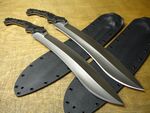
|
Used by non-commissioned officers for ceremonial occasions. Loosely modeled after the falcata used by Iberian soldiers during the early imperial period. | |||
| Model 76 | Officers' sword | 82 cm (32 in) | 
|
Used by commissioned officers for ceremonial occasions. Loosely modeled after Moroccan nimcha blades, and historically used by cavalry. | |||
Firearms
Pistols
| Pistols | |||||||
|---|---|---|---|---|---|---|---|
| Name | Origin | Type | Caliber | Photo | Notes | ||
| G/ISP-121AM2 | Semi-automatic pistol | 10×22mm ASP-65 | 
|
Introduced in 1976 with the adoption of the 10×22mm caliber as the ARP-27, redesignated the G/ISP-121 under the Millennium Inventory System. It is a self-loading, semi-automatic pistol, and replaced the AEP-25 as the standard sidearm of the Defense Forces. | |||
| G/ISP-122 | Semi-automatic pistol | 10×22mm ASP-65/06 | 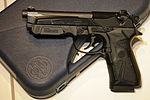
|
New standard issue pistol introduced in 2006, replacing the G/ISP-121. It was selected for its lighter weight and improved ergonomics relative to the G/ISP-121 when -121 frames began to wear out. The G/ISP-122 also includes an integrated rail mount on the frame for accessories and a recoil buffer to make firing more comfortable. | |||
Rifles
| Rifles | |||||||
|---|---|---|---|---|---|---|---|
| Name | Origin | Type | Caliber | Photo | Notes | ||
| G/IAR-101 | Assault rifle Carbine |
5.5×42mm ASR-64/07 | 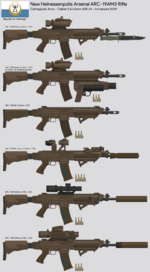
|
Previous standard assault rifle, introduced in 1965 as the ARC-19. Phase out began in 2016 in favor of the G/IAR-102, though large numbers remain in service. Redesignated G/IAR-101 under MIS. | |||
| G/IAR-102 G/IAR-102C |
Assault rifle Carbine |
6.25×45mm Ctesiphon PCTA | 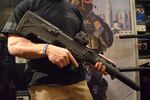
|
Standard assault rifle, with compact variants for vehicle crews. Introduced in 2016, it replaced the conventional ARC-19 (G/IAR-101) and introduced the 6.25×45mm Ctesiphon PCTA cartridge, along with a new bullpup configuration and rising chamber action. The rifle incorporates a powered rail system for use with the Future Combat Infantryman System, incorporating an electronic sight, laser rangefinder, and provisions for an airbursting grenade launcher attachment. | |||
| G/ISR-103 | Sniper rifle | 7.8×80mm ASR-65 | 
|
Sniper rifle introduced in 1983 as the DMS-22, now being replaced by the G/ISR-106. | |||
| G/IMR-104 | Anti-material rifle | 12.7×99mm BMG (ASM-21) | 
|
Anti-material rifle adopted in 1994, intended to engage targets ranging from light armored vehicles, parked aircraft, radar installations, field fortifications, ammunition dumps, and light watercraft. Like several other anti-material rifle designs, it is semi-automatic. Due to its construction, the barrel can be folded at its attachment point to the bolt for more compact carry and stowage. | |||
| G/IMR-105 | Anti-material rifle | 12.7×99mm BMG (ASM-21) | 
|
Compact anti-material rifle introduced in 2013 to supplement and replace the G/ISR-104. With a bullpup, recoil-absorbing design, the G/ISR-104 is lighter and much more comfortable to fire than the G/ISR-103. Like the G/ISR-104, the -105 is a semi-automatic design and is normally fed from a 10-round box magazine. It is equipped with provisions to mount and interface with the G/ETM-905 and G/ETM-906 electronic sights originally developed for the DMS-24 (G/ISR-105). | |||
| G/ISR-106 | Sniper rifle | 9×92mm ASR-07 | 
|
Primary sniper rifle, introduced in 2009 and developed under the DMS-24 designation. Designed around the use of the 9×92mm Desert cartridge, the G/ISR-106 has a weight comparable to rifle-caliber sniper rifles but range and energy similar to heavy machine gun calibers. While primarily used against soft targets, it can also defeat a number of light armored targets using standard HEIAP ammunition. The -106 is normally issued with either the G/ETM-905 or G/ETM-906 25x electronic sights capable of computing the necessary aiming point and adjusting the trigger pull, but can be used with conventional optical and night vision sights. | |||
| G/IGR-118 | Grenade rifle | 30×56mm ASG-16 | 
|
Grenade rifle used as a squad support weapon against fortifications, light vehicles, groups of infantry, and for indirect fire support. | |||
Machine guns
| Machine guns | |||||||
|---|---|---|---|---|---|---|---|
| Name | Origin | Type | Caliber | Photo | Notes | ||
| G/IMR-120 | Light machine gun | 5.5×42mm ASR-64/07 | 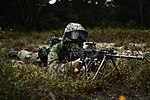
|
Light machine gun used to provide support for infantry squads. In the process of being replaced by the G/IAR-102M LMG variant of the G/IAR-102 assault rifle. | |||
| G/IMG-121 | Heavy machine gun | 12.7×99mm BMG (ASM-21) | 
|
Heavy machine gun commonly used on vehicles, helicopters, small boats, and other platforms. Also available in man-portable crew-served variants. The current -AM1 variant is designed to lighten the weapon for greater portability, while vehicle mounted variants are being replaced with the more powerful 15.5 mm G/IMG-122 machine gun and CRA-334 revolver cannon. Due to the size and weight of weapons chambered in 15.5 mm PCTA, it is expected the G/IMG-121 will remain in service for infantry support roles. | |||
| G/IMG-122 | Heavy machine gun | 15.5×105mm Tabnit PCTA (ASM-18) | 
|
Heavy machine gun introduced for use on vehicles, helicopters, and other fixed platforms. The G/IMG-122 was the first weapon introduced to use polymer cased telescoped ammunition, but is impractical for use by infantry and is limited to vehicle and ship mounts. Like the G/IMR-120 and G/IMG-121, the G/IMG-122 uses a constant recoil system to reduce felt recoil. | |||
| G/IAG-127 | Grenade machine gun | 30 x 45 mm | 
|
Grenade machine gun used on vehicles and in man-portable versions as an infantry support weapon. The G/IAG-127 is lighter, more portable, and has better accuracy than the older G/IAG-126 it replaces. | |||
Shotguns
| Shotguns | |||||||
|---|---|---|---|---|---|---|---|
| Name | Origin | Type | Caliber | Photo | Notes | ||
| G/IHS-110 | Semi-automatic shotgun | 12-gauge | 
|
Semi-automatic shotgun introduced in 1994. It is fed from an 8-round magazine with a maximum effective range of 140 m (460 ft) for solid shot and 40 m (130 ft) for buckshot. It is commonly used during urban operations for breaching purposes as well as aboard ships. | |||
| G/IHS-111 | Pump-action shotgun | 12-gauge | Used by various units as a breaching shotgun. | ||||
Submachine guns
| Submachine guns | |||||||
|---|---|---|---|---|---|---|---|
| Name | Origin | Type | Caliber | Photo | Notes | ||
| G/IAP-115 | Submachine gun | 10×22mm ASP-65/06 5.8×22mm ASP-12S |
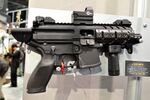
|
Widely used by special forces, military police, and other special action groups. Fielded in multiple variants, including suppressed and full stock models, and reduced-length versions for concealed carry. | |||
Explosives
Grenades
| Grenades | |||||||
|---|---|---|---|---|---|---|---|
| Name | Origin | Type | Detonator | Photo | Notes | ||
| G/LGF-130 | Fragmentation grenade | Timed fuse | 
|
Standard fragmentation grenade of the Carthage Defense Forces, of a modular design capable of accepting additional charges, a stick for throwing, and different fuzes for use as a makeshift mine or booby trap. | |||
| G/LGM-131 | Smoke grenade | Timed fuse | Standard smoke grenade available in red, yellow, green, and violet. | ||||
| G/LGS-132 | Stun grenade | Timed fuse | 
|
Standard stun grenade, designed to incapacitate targets via flash blindness, deafness, and inner ear disturbance. | |||
Mortars
| Mortars | |||||||
|---|---|---|---|---|---|---|---|
| Name | Origin | Type | Caliber | Photo | Notes | ||
| G/LMM-170AM2 | Mortar | 60 mm | 
|
60 mm light mortar used for infantry support. Carried by company-level mortar carriers for use when dismounted in armored, cavalry, and marine brigades and by company mortar platoons for airborne and air assault brigades. | |||
| G/LMM-171AM1 | Mortar | 82 mm | 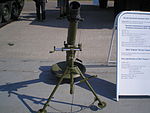
|
82 mm infantry mortar used in light infantry, airborne, and air assault brigades for organic battalion level fire support. Battalion-level 120 mm mortar carriers (WFM-34 and GMM-26) also carry an 82 mm mortar for dismounted use. The current -AM1 variant incorporates a weight and labor saving redesign of certain components to improve mobility and reduce cost. | |||
| G/LMM-172 | Automatic mortar | 120 mm | 
|
120 mm mortar module designed for use either mounted within an armored carrier or in a trailer-borne stand-alone configuration. The system can automatically elevate, slew, load, and fire the gun in response to commands from a remote station, significantly reducing the manpower required to operate the weapon. The module is carried by WFM-34 Buccaneer wheeled and GMM-26 Pandarus tracked carriers for use in marine and cavalry brigades at the battalion and company level. The trailer-borne variant is used by light infantry brigades and is airmobile via helicopter for use in airborne and air assault brigades. | |||
Anti-materiel weapons
| Anti-materiel weapons | |||||||
|---|---|---|---|---|---|---|---|
| Name | Origin | Type | Warhead | Photo | Notes | ||
| G/LLM-150 | Anti-structure weapon | 90 mm (3.5 in) | 
|
Disposable man-portable anti-structure munition. It is primarily employed to defeat hardened structures, bunkers, and other fortifications, but has a multi-mode fuze and alternative munitions for anti-armor use. Current versions incorporate a counter-mass system for safe use in enclosed spaces. | |||
| G/LLM-151AM7 | Anti-structure weapon | 66 mm (2.6 in) | 
|
Lightweight, disposable multi-purpose launcher first introduced in 1967. The weapon's low weight allows it to be carried in regular operations without significantly increasing the squad's weight. Current variants include anti-armor and anti-personnel munitions, including smart fuzes to allow post-penetration detonation as well as a counter-mass system for use from enclosed spaces. | |||
| G/LLM-152 | Multi-role assault | 84 mm (3.3 in) | 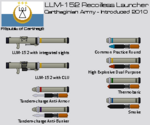
|
Reusable multi-purpose designed for use as a flexible squad support weapon. It is the current standard squad assault launcher and LLM-152 teams generally carry a mix of anti-bunker, anti-tank, and smoke rounds. As a reusable weapon, it has more robust sighting systems than the disposable LLM-150 and LLM-151 and is compatible with the same command launch unit used with the SMM-760 series for greater accuracy. | |||
| Type-42 | Anti-tank weapon | 135 mm (5.3 in) | 
|
Man-portable and vehicle-mounted anti-tank guided missile using SACLOS guidance. Retired in all but militia service in favor of members of the SMM-760 Chihaya series, the Type 42 was not reclassified under MCS. | |||
| SMM-760 Chihaya | Anti-tank weapon | 130 mm (5.1 in) | 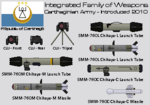
|
Family of IR-guided anti-tank missiles ranging from man-portable short-range launchers to large vehicle and aircraft-launched systems. The man-portable variants are designed to be used with a detachable and reusable command launch unit for surveillance and targeting purposes. | |||
| SMI-750AM2 | Anti-air weapon | 72 mm (2.8 in) | 
|
IR-guided man-portable anti-aircraft missile. Originally developed as the Type-115, the current SMI-750AM2 variant has a new three-sensor seeker, a new datalink capabilities to enable cuing by external sensors, and a more powerful rocket motor for improved kinematic performance. | |||
| SMI-751 Kotori | Anti-air weapon | 3 x 22 mm (0.87 in) | 
|
Man-portable anti-aircraft missile with three submunitions, guided via beam-riding SACLOS. Designed for use from vehicles, helicopters, as well as man-portable launchers. The current variant has a range of up to 7,000 meters (23,000 ft) and can be used against ground vehicles. The current command unit can also receive network updates on battlefield air threats, providing an improved reaction time. | |||
Mines
| Mines | |||||||
|---|---|---|---|---|---|---|---|
| Name | Origin | Type | Detonator | Photo | Notes | ||
| G/LMP-140 | Anti-personnel mine | Remote | 
|
Used for area denial, defensive, and specialist purposes. | |||
| G/LMP-141 | Anti-personnel mine | Pressure | 
|
Used for area denial purposes, often in conjunction with anti-tank mines. It is a conventional pressure-detonated anti-personnel mine but incorporates an overpressure-resistant design and minimum metal design to make minesweeping more difficult. It can be hand-laid or scattered via the helicopter and vehicle-borne Torrent mine system. | |||
| G/LMP-142 | Anti-personnel mine | Tripwire | 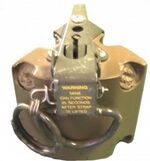
|
Area denial munition used by special forces units to deter pursuing enemy troops. After activation, the mine deploys a series of tripwires and detonates when any of the tripwires detect contact. To improve lethality, the G/LMP-143 is a bounding mine, and is designed to expire 4 hours after being activated. Also delivered via artillery. | |||
| G/LMT-143 | Anti-tank mine | Pressure | 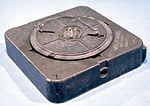
|
Anti-tank minimum metal mine. Although largely retired from service, it is retained in reserve stockpiles. | |||
| G/LMT-144 | Anti-tank mine | Pressure | Bar-shaped anti-tank mine designed to increase the mine's pressure plate area, increasing the probability of detonation by a passing vehicle. Much easier and more efficient to lay, it has replaced the G/LMT-143 as the primary manually-laid mine system of the Carthage Defense Forces. | ||||
| G/LMT-145 | Off-route mine | Seismic/Acoustic | 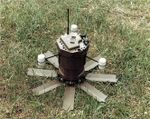
|
Off-route area mine using seismic and acoustic sensors to detect the movement of vehicles within a 100 m (330 ft) radius. Upon detection, the mine aims and fires an IR-fuzed EFP submunition designed to detonate above the target vehicle. Due to its cost per unit, the mine is designed to be recovered if not expended. It is most commonly employed by special forces teams for deep emplacement operations. A datalink-enabled variant of the mine is under development. | |||
Vehicles
Armored
| Armored vehicles | |||||||
|---|---|---|---|---|---|---|---|
| Name | Origin | Type | Number | Photo | Notes | ||
| HTA-01 Rhinoceros | Main battle tank Driver training tank |
52,950 | 
|
Previous-generation main battle tank, originally designated MBT-74. A total of 89,560 tanks were delivered to the Army over the course of production, with 52,950 remaining in inventory after combat losses, sales to foreign customers, and the scrapping of damaged or obsolete vehicles. Production of the HTA-01 ended in 2013.
The HTA-01 is being replaced by the newer HTA-02, but still equips the reserve units. It is expected to be fully replaced in active units by 2019 and in reserve units by 2022. | |||
| HTA-02 Jaguar II | Main battle tank Driver training tank |
14,600 | 
|
New main battle tank introduced in 2011 and projected to replace the HTA-01 Rhinoceros in all roles. As with the HTA-01, the HTA-02 equips the armored battalions of the Army's brigade combat teams. | |||
| GCV-20 Diomedes GIV-21 Andromache GRC-22 Patroclus GRF-23 Dolon GIC-24 Agenor GHM-25 Teucer GMM-26 Pandarus GEV-27 Polydamas GER-28 Antenor GAV-29 Penelope GVE-30 Nestor GDE-31 Sarpedon GAV-32 Cassandra |
Light tank Infantry fighting vehicle Cavalry fighting vehicle Fire control vehicle Armored personnel carrier Self-propelled howitzer Self-propelled mortar Armored recovery vehicle Armored repair vehicle Armored ambulance Armored command vehicle Mobile battlefield radar Short-range air defense |
47,545 | 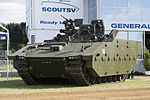  
|
Common vehicle family designed on a standard chassis and introduced to equip light cavalry divisions, developed under the Iliad Medium Multipurpose Tracked Vehicle program. The Iliad family is designed to provide superior protection and firepower to previous vehicles in the 25-35 tonne weight class with better integration of modern battlefield systems while remaining airmobile in new-generation tactical airlifters. The development of the GCV-20 series was a cornerstone of the Army 2010 plan and the series is expected to have sufficient room for growth to remain in service for several decades. Up-armor packages allow the vehicle to operate at weights above 45 tonnes.
While designed for service in light cavalry divisions, the common tracked platform is used in specialist vehicles assigned to both armored and infantry brigades where heavier or lighter platforms would be inappropriate. | |||
| GIV-87 Swordsman | Infantry fighting vehicle | 51,240 | 
|
Infantry fighting vehicle being replaced by the HIV-06 Eryx in armored brigades and the Iliad MMTV series in light cavalry brigades. | |||
| GIC-90 Swordsmith | Armored personnel carrier | 25,560 | 
|
Multi-purpose vehicle family being replaced by the GCV-20 and GIC-91 series. Originally introduced as the APC-64 armored personnel carrier in the 1960s, the type has been converted to serve in almost every role and is found in nearly every brigade. Despite being replaced in front line combat tasks by newer vehicles, the type is expected to remain in service in various rear-line and training duties until well into the 2030s. | |||
| GIC-91 Bladesmith | Armored personnel carrier | 3,560 | 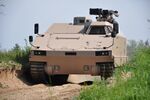
|
Multi-purpose vehicle family replacing the GIC-90 Swordsmith series. While heavier than the GIC-90 and not amphibious, the GIC-91 Bladesmith platform has a significantly more powerful engine, stronger suspension, better protection, and a larger payload capacity than the GIC-90, enabling it to better support the needs of maneuver units in the field. The GIC-91 also features improved modularity, being able to substitute equipment sets at the depot rather than the factory level. | |||
Engineering
| Engineering vehicles | |||||||
|---|---|---|---|---|---|---|---|
| Name | Origin | Type | Number | Photo | Notes | ||
| HET-11 Thoas | Armored recovery vehicle | 4,654 | 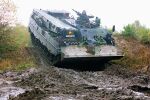
|
Armored recovery vehicle built on the chassis of the HTA-02 Jaguar II, introduced due to the inability of the previous HTA-01-based recovery vehicle to effectively service the heavier Jaguar II. The HET-11 fully replaced the previous REC-334 in early 2016 and was considered the highest-priority replacement program. | |||
| HEC-12 Ajax | Combat engineering vehicle | 1,205 | 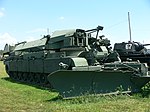
|
Combat mobility vehicle designed for counter-mine operations and to breach barricades and other obstacles. Built on the chassis of the HTA-02 Jaguar II. The HEC-12 includes a constant-depth mine plow, mine-clearing line charge, and excavator to clear minefields and improvised explosive devices while protected from enemy fire. | |||
| HEB-13 Moses | Armored vehicle launched bridge | 1,450 | 
|
Armored vehicle-launched bridge used to support tanks and other heavy vehicles in crossing rivers, canals, ditches, and other small obstacles. The bridge is composed of up to three segments that can be combined to create a bridge up to 28 meters (92 ft) in length and capable of supporting weights up to 75 tonnes. | |||
| WEB-273 | Armored vehicle launched bridge | 720 | 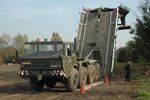
|
Self-deployed scissor bridge carried on a WVH-71 Bison 10x10 chassis and used by infantry brigades for bridging purposes. Individual bridge spans are 12.5 meters (41 ft) but can be combined to reach lengths of up to 108 meters (354 ft). The bridge is rated to support weights up to 50 tonnes. | |||
| HEC-35 Phoenix | Combat engineering vehicle | 1,105 | 
|
Armored combat earthmover designed to break through and construct earthwork barriers, build tank fighting emplacements, and provide other mobility support functions. Built on the chassis of the HTA-01 Rhinoceros. | |||
| WCE-82 Khzir | Excavator | 3,420 | 
|
Armored excavator used by combat engineers for field earthmoving tasks. | |||
| WHV-50 Darius | Amphibious bridging vehicle | 450 | 
|
Amphibious rig capable of operating either as a ferry or joined together to form a bridge capable of supporting vehicles up to and including main battle tanks. Assigned to specialized engineering units and deployed as needed to theaters where frequent river crossings are expected. | |||
Artillery
| Artillery | |||||||
|---|---|---|---|---|---|---|---|
| Name | Origin | Type | Number | Photo | Notes | ||
| CCH-410 Baleares | Towed howitzer | 2,950 | 
|
Lightweight 105 mm towed howitzer used by airborne brigades in lieu of heavier self-propelled artillery. Introduced in 2001, it replaced the HWM-97 and is the last 105 mm gun in Carthaginian service. The CCH-410 is designed to minimize weight to improve air mobility and introduces a number of titanium components to replace previous steel fittings to allow transport via medium helicopter. | |||
| CCH-411 Crete | Towed howitzer | 3,400 | 
|
Lightweight 155 mm towed howitzer used by airmobile brigades. At 4,200 kg it is nearly 3 tonnes lighter than the HWL-85 it replaces. An L/52 variant using the modified barrel of the CCH-412 is being evaluated as an upgrade for part or all of the CCH-411 fleet. | |||
| CCH-412 Rhodes | Towed howitzer | 4,500 | 
|
Towed 155 mm howitzer used by light infantry brigades. The CCH-412 is equipped with a diesel APU providing a maximum self-propelled speed of 16 km/h (9.9 mph) and power for the semi-automatic loading system. Additional units are held in storage for use by Militia forces during wartime activation. | |||
| SPH-87 Parthian | Self-propelled howitzer | 15,560 | 
|
Self-propelled howitzer armed with 155 mm L/52 gun. Introduced in 1985 to replace the SPH-74 with a significant reduction in crew requirements, the SPH-87 is in the process of being replaced by the HHM-09 Bowman in armored brigades. | |||
| SPR-88 Squire | Resupply vehicle | 15,560 | 
|
Armored resupply vehicle based on the chassis of the SPH-87 and designed to support it in the field. Carries up to 90 additional shells and propellant charges. Being replaced by the HHA-10 Fletcher. | |||
| HHM-09 Bowman | Self-propelled howitzer | 4,300 | 
|
Self-propelled howitzer armed with 155 mm L/56 liquid-cooled gun and manned by a crew of two thanks to an autoloader and improved automation of tasks. It is used to equip the artillery contingent of armored brigades.
A standalone gun module using the same components but a shorter barrel is in use in the lighter GMM-26 Teucer and WFH-44 Cutthroat howitzers. The type retains full compatibility with existing ammunition types. | |||
| HHA-10 Fletcher | Resupply vehicle | 4,300 | 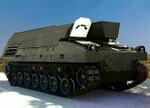
|
Armored resupply vehicle designed to accompany and support the HHM-09 Paris SPH. 100 additional rounds plus propellant charges can be carried onboard and resupply can be managed under armor via retractable boom for improved crew safety. | |||
| HHM-18 Oshosi | Self-propelled howitzer | 820 | Heavy self-propelled howitzer armed with 210 L/52 gun used by corps artillery brigades to neutralize and destroy deep targets. It is built on many of the same technologies as the 155 mm HHM-09 Bowman and is a replacement for the preceding 210 mm SPG-68. | ||||
| HHA-19 Ogun | Resupply vehicle | 800 | 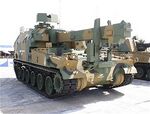
|
Armored resupply vehicle designed to accompany the HHM-18 Oshosi SPH. Similar to the HHA-10 Fletcher, it is capable of carrying 72 rounds and propellant charges. | |||
| MLR-159 Tatsumaki | Multiple rocket launcher | 9,540 | 
|
Multiple rocket launcher used at the divisional and corps level to provide focused bombardment capabilities and based on the GIV-89 Swordsman chassis, in the process of being replaced by the HOM-14 Apollo. Also equipped to launch the TDR-592 Shapash tactical ballistic missile. | |||
| HOM-14 Apollo | Multiple rocket launcher | 3,750 | 
|
Multiple rocket launcher used at the divisional and corps level to provide saturation bombardment for brigades, replacing the MLR-159. Also equipped to launch the TDR-592 Shapash tactical ballistic missile. | |||
Air defense
| Air defense | |||||||
|---|---|---|---|---|---|---|---|
| Name | Origin | Type | Number | Photo | Notes | ||
| SPA-142 Saunion | Self-propelled air defense system | 9,700 | 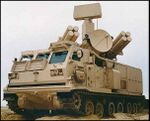
|
Self-propelled air defense system armed with radar-cued 25 mm chain guns and short-range missiles and built on the hull of the GIV-87 Swordsman IFV. Introduced in 1983 and in the process of being replaced by the HCV-20 Shango. | |||
| HCV-20 Shango | Self-propelled air defense system | 1,300 | 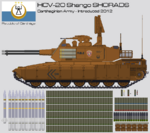
|
Self-propelled air defense system armed with a 50 mm rotary cannon and laser-guided missiles, built on the chassis of the HTA-02 Jaguar II tank. The HCV-20 has a much greater emphasis on the C-RAM mission than the SPA-142 it replaces and better performance against smaller targets like drones and cruise missiles. | |||
| WIL-50C Wallaby | Self-propelled air defense system | 4,400 | 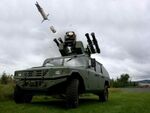
|
Mobile launcher for the SMI-751 Kotori surface-to-air missile system mounted on a Wallaby weapons carrier chassis. Each vehicle carries four ready missiles for air defense and a 15.5 mm machine gun for self-defense. | |||
| Tarnhelm | Surface-to-air missile Anti-ballistic missile |
1,456 | 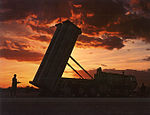
|
Integrated medium and long-range surface-to-air missile system with anti-ballistic missile capability. | |||
Logistics
| Logistics | |||||||
|---|---|---|---|---|---|---|---|
| Name | Origin | Type | Number | Photo | Notes | ||
| WIL-50 Wallaby | Multipurpose utility vehicle | ~2,570,000 | 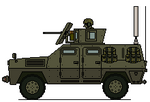
|
Multipurpose utility and combat vehicle available in 4x4 and 6x6 configurations with payloads up to 2,700 kg (6,000 lb). The current Generation III design includes improved protection against improvised explosive devices, better survivability, and improved fuel economy. Additional armor kits are also available for combat variants and operations in hostile territory. | |||
| WVH-70 Lusitano | Medium logistics vehicle | ~1,050,000 | 
|
Medium logistics platform with a 4x4 6-tonne base variant introduced in 2002. Certain newer models include onboard power generation capability to reduce reliance on external generators. The current Generation II design entered service in 2012 and features an improved suspension and new engine for better cross-country performance. | |||
| WVH-71 Bison | Heavy logistics vehicle | ~850,000 | 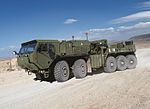
|
Heavy logistics platform based on a 10x10 16-tonne platform introduced in 2010. The WVH-71 is the first hybrid electric vehicle to enter general service in the Carthage Defense Forces. Up-armor kits are also available, as are armament kits to install a roof-mounted weapons station. | |||
| WVH-72 Buffalo | Heavy vehicle transporter | ~44,000 | 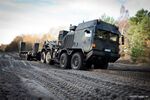
|
Heavy vehicle transporter introduced in 1996, with the current -AM1 variant introduced alongside the HTA-02 Jaguar II in order to accommodate the new tank's greater weight. The -AM1 incorporates a more powerful 850 hp (630 kW) engine with improved fuel efficiency and range, while retaining space in the cab for vehicle crews. The WVH-72AM1 has a maximum towing load of 80 tonnes, allowing it to haul a fully up-armored Jaguar II. | |||
Amphibious
| Amphibious | |||||||
|---|---|---|---|---|---|---|---|
| Name | Origin | Type | Number | Photo | Notes | ||
| HFV-40 Neptune | Amphibious assault vehicle | 3,650 | 
|
Amphibious assault vehicle designed to be deployed from assault ships offshore and ferry troops across the beach. The HFV-40 replaces the ICA-79 and includes significantly improved protection and speed over water. | |||
| WFV-41 Wako WFC-42 Corsair WFM-43 Buccaneer WFH-44 Cutthroat WFV-45 Privateer WFE-46 Kingpin |
Armored personnel carrier Reconnaissance vehicle Mortar carrier Self-propelled howitzer Armored recovery vehicle Armored command vehicle |
14,540 | 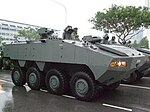
|
8x8 amphibious vehicle used to equip marine units as well as independent maneuver battalions in support of light infantry divisions. The WFV-41 series provides the primary mobility platform for marine units and fulfills a role analogous to the Iliad MMTV series but with greater emphasis on amphibious capabilities. | |||
Miscellaneous
| Miscellaneous | |||||||
|---|---|---|---|---|---|---|---|
| Name | Origin | Type | Number | Photo | Notes | ||
| WLU-61 Dingo | Light utility vehicle | ~760,000 | 
|
Light utility vehicle largely replaced in combat roles by the WIL-50 Wallaby series. Remaining vehicles of the WLU-61 series are still commonly used for liaison and general auxiliary tasks in peacetime and for reserve units not re-equipped with Wallabies. | |||
| WRN-62 Sundance | Dispatch motorcycle | ~75,000 | 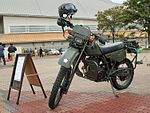
|
Motorcycle used for dispatch, liaison, traffic control, reconnaissance, and other miscellaneous purposes. | |||
| WVL-63 Starshine | Light utility vehicle | ~65,000 | 
|
Light utility vehicle designed to be internally transportable in medium and heavy-lift helicopters, providing support for airmobile infantry. | |||
| WLC-64 Sandstorm | Light strike vehicle | 2,400 | 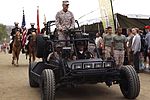
|
All-terrain dune buggy employed by special forces units in desert or other rough terrain for reconnaissance and strike missions. | |||
| WLU-65 Starfield | Offroad utility vehicle | 7,200 | 
|
All-terrain 6x4 vehicle used in support of light supply deliveries, medical evacuation and patient transport, and other utility roles. | |||

